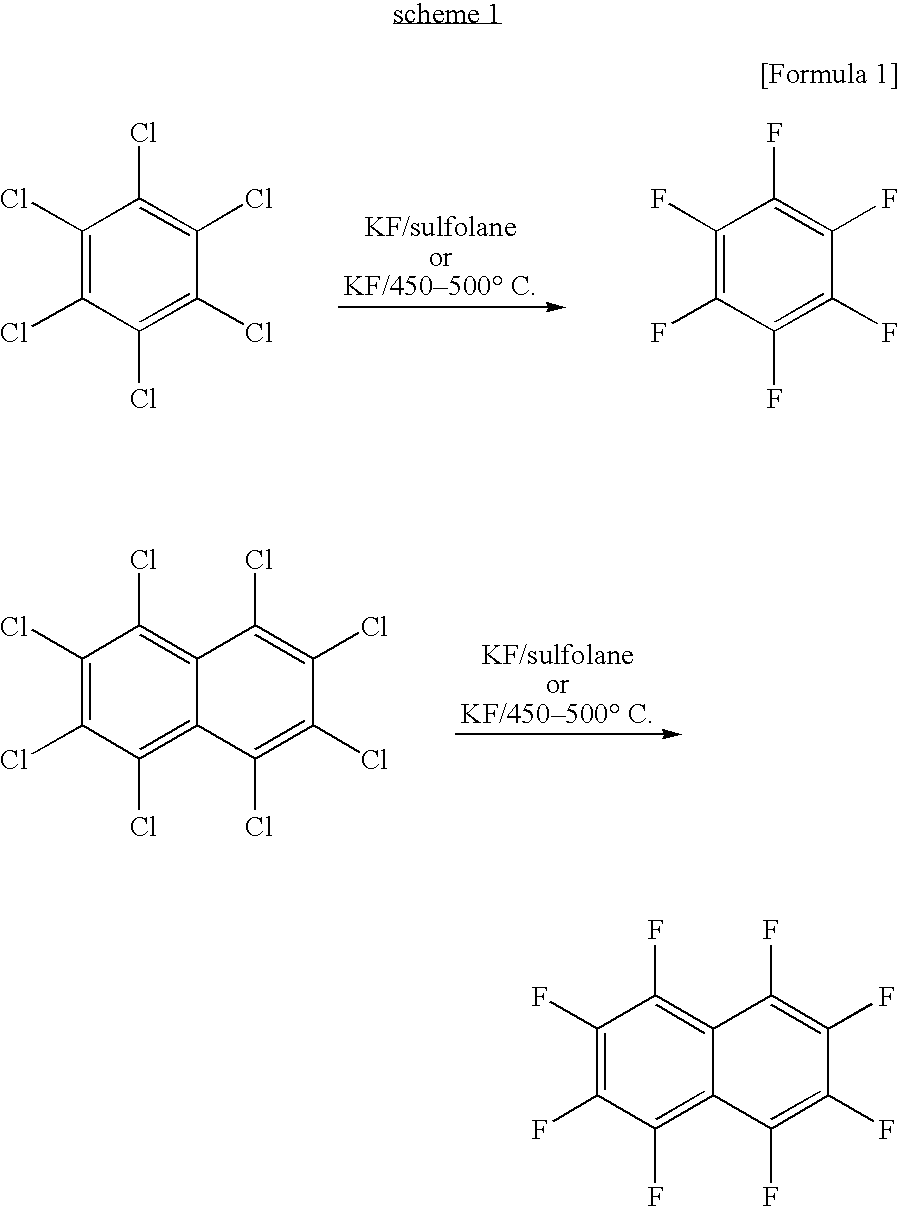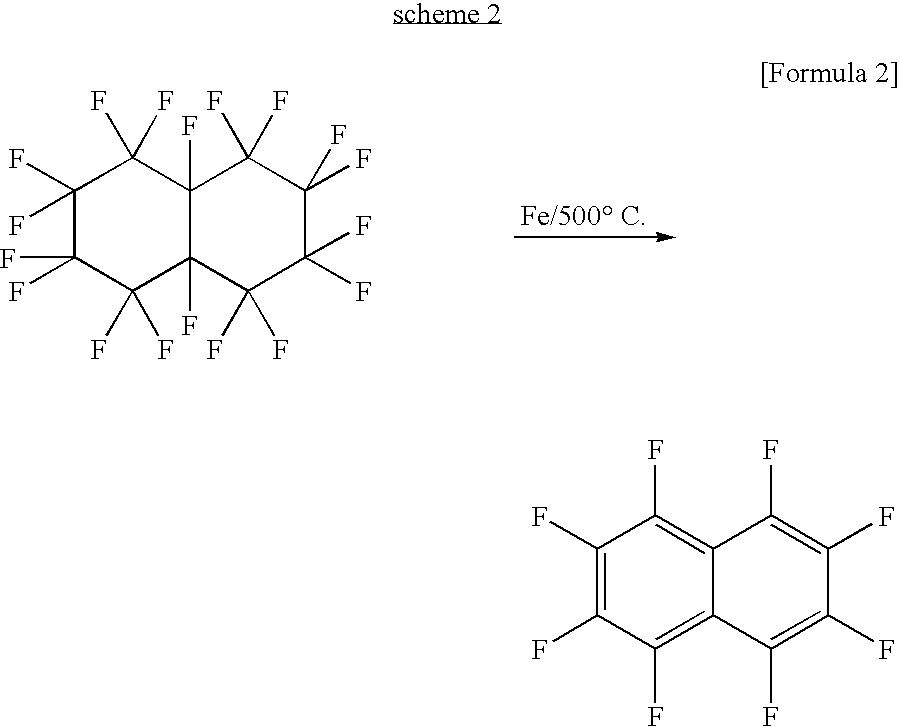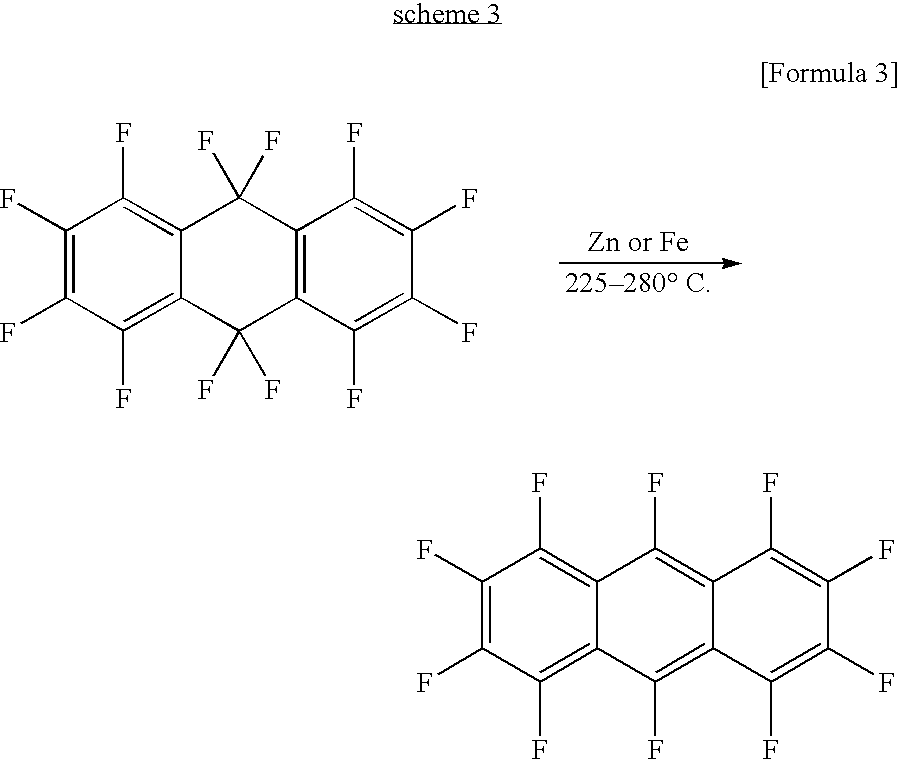Fluorinated pentacene derivative and method of producing same
a technology of fluorinated pentacene and derivatives, which is applied in the preparation of carbonyl compounds, halogenated hydrocarbon preparations, organic chemistry, etc., can solve the problems of difficult to obtain fluorinated pentacene derivatives, and inability to prepare tetradecafluoropentacen
- Summary
- Abstract
- Description
- Claims
- Application Information
AI Technical Summary
Problems solved by technology
Method used
Image
Examples
example 1
Synthesis of 1,2,3,4,8,9,10,11-octafluoro-5,7,12,14-tetrahydroxypentacen-6,13-dione (3)
[0164]4,5,6,7-tetrafluoroisobenzofuran-1,3-dione (2) (5.75 g, 26.1 mmol), 5,6,7,8-tetrafluoro-9,10-dihydroxy-2,3-dihydroanthracen-1,4-dione (1) (9.84 g, 31.3 mmol), aluminum chloride (1.53 g, 11.5 mmol), and sodium chloride (10.0 g, 171 mmol) were added to a 200-mL SUS autoclave and heated for 1 hour at 280° C. After completion of the reaction, cooling to room temperature was carried out and the reaction mixture was then introduced into dilute hydrochloric acid and was stirred for 1 hour at 100° C. The mixture was then filtered and the residue was washed with methanol, dichloromethane, toluene, and ether in the sequence given. The resulting solid was vacuum dried to give 11.5 g (85% yield) 1,2,3,4,8,9,10,11-octafluoro-5,7,12,14-tetrahydroxypentacen-6,13-dione (3).
[0165]melting point: 300° C. (decomposition)
[0166]mass analysis (MS m / z): 516 (M+, 100) 258 (29).
[0167]
elemental analysiscalculated for ...
example 2
Synthesis of 1,2,3,4,5,5,6,6,7,7,8,9,10,11,12,12,13,13,14,14-eicosafluoro-5,6,7,12,13,14-hexahydropentacene (7)
[0168]1,2,3,4,8,9,10,11-octafluoro-5,7,12,14-tetrahydroxypentacen-6,13-dione (5 g, 9.68 mmol) was introduced into a 500-mL SUS autoclave; the vessel was cooled to −78° C.; and hydrogen fluoride (100 g) and then sulfur tetrafluoride (25 g, 231 mmol) were added. Heating was thereafter carried out to 150° C. with the reaction vessel sealed. The pressure in the reaction vessel reached 4.0 MPa (gauge pressure) at this time. After reaction for 96 hours, the reaction vessel was slowly cooled to room temperature and the low-boiling compounds were gradually discarded into a detoxification apparatus. Nitrogen was introduced into the vessel when the internal pressure reached ambient pressure and the residual hydrogen fluoride was completely eliminated. The reaction product (6.6 g) was then extracted with 600 mL hot chloroform, and filtration and then concentration of the solution gave...
example 3
Synthesis of 1,2,3,4,5,5,6,6,7,7,8,9,10,11,12,12,13,13,14,14-eicosafluoro-5,6,7,12,13,14-hexahydropentacene (7)
[0175]1,2,3,4,8,9,10,11-octafluoro-5,7,12,14-tetrahydroxypentacen-6,13-dione (3) (10 g, 19.4 mmol) was introduced into a 500-mL Hastelloy C autoclave; the vessel was cooled to −78° C.; and hydrogen fluoride (100 g) and then sulfur tetrafluoride (36 g, 323 mmol) were added. Heating was thereafter carried out to 150° C. with the reaction vessel sealed. The pressure in the reaction vessel reached 4.0 MPa (gauge pressure) at this time. After reaction for 68 hours, the reaction vessel was slowly cooled to room temperature and the low-boiling compounds were gradually discarded into a detoxification apparatus. Nitrogen was introduced into the vessel when the internal pressure reached ambient pressure and the residual hydrogen fluoride was completely eliminated. The reaction product (13.3 g) was then extracted with 1.5 L hot chloroform, and filtration and then recrystallization gav...
PUM
| Property | Measurement | Unit |
|---|---|---|
| temperature | aaaaa | aaaaa |
| temperature | aaaaa | aaaaa |
| temperature | aaaaa | aaaaa |
Abstract
Description
Claims
Application Information
 Login to View More
Login to View More - R&D
- Intellectual Property
- Life Sciences
- Materials
- Tech Scout
- Unparalleled Data Quality
- Higher Quality Content
- 60% Fewer Hallucinations
Browse by: Latest US Patents, China's latest patents, Technical Efficacy Thesaurus, Application Domain, Technology Topic, Popular Technical Reports.
© 2025 PatSnap. All rights reserved.Legal|Privacy policy|Modern Slavery Act Transparency Statement|Sitemap|About US| Contact US: help@patsnap.com



